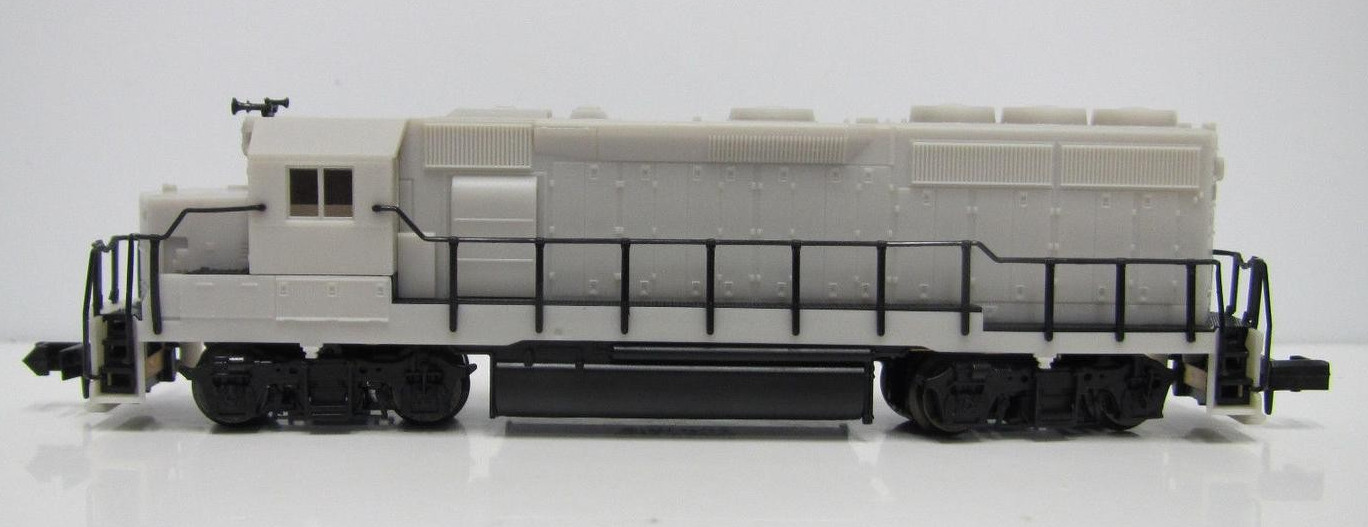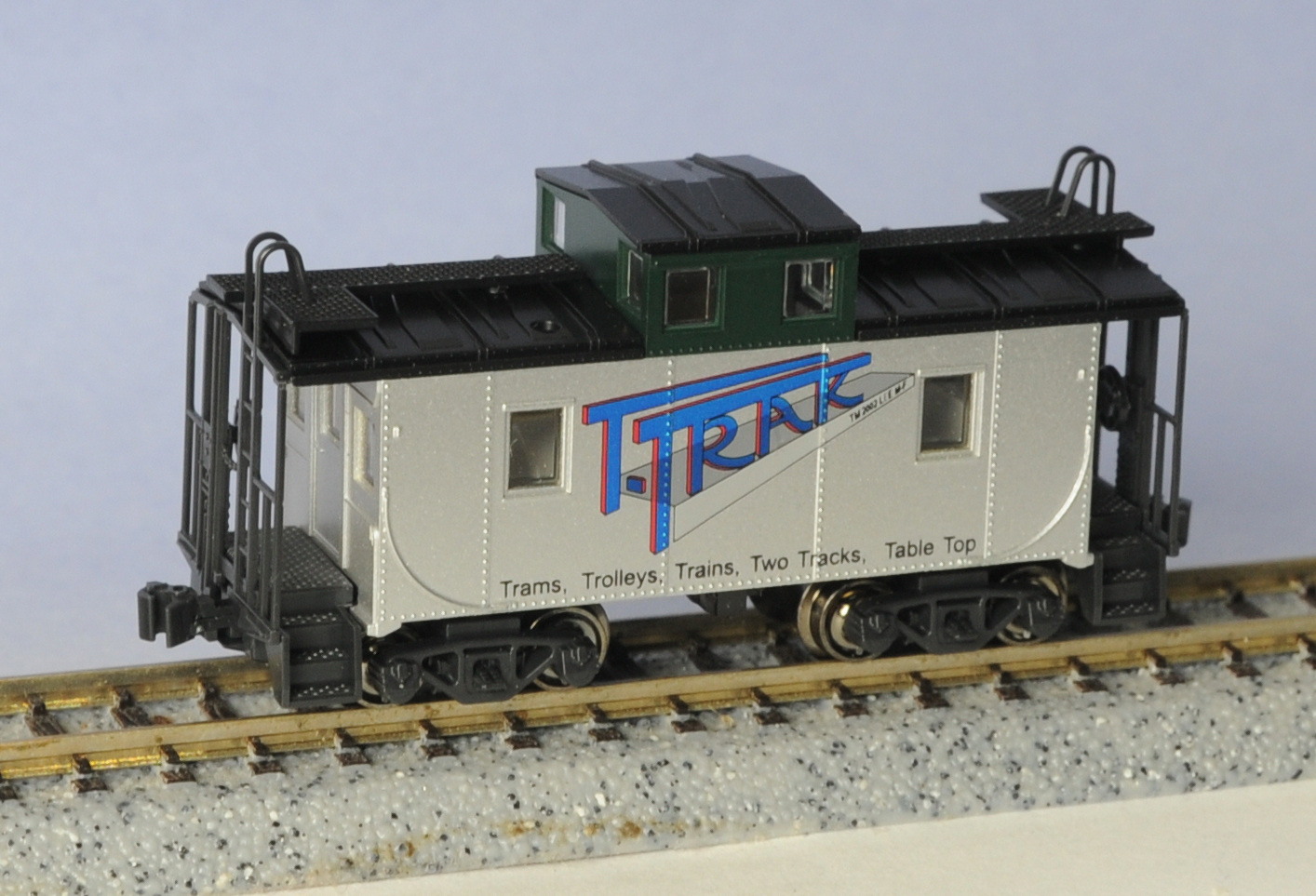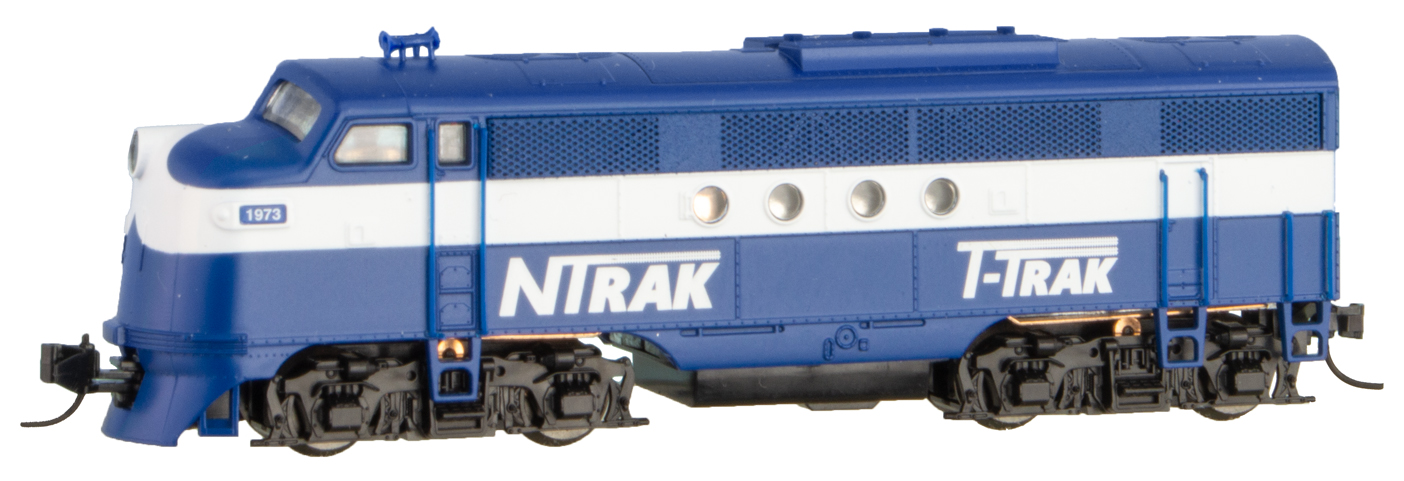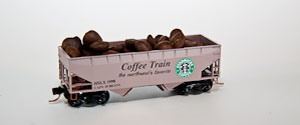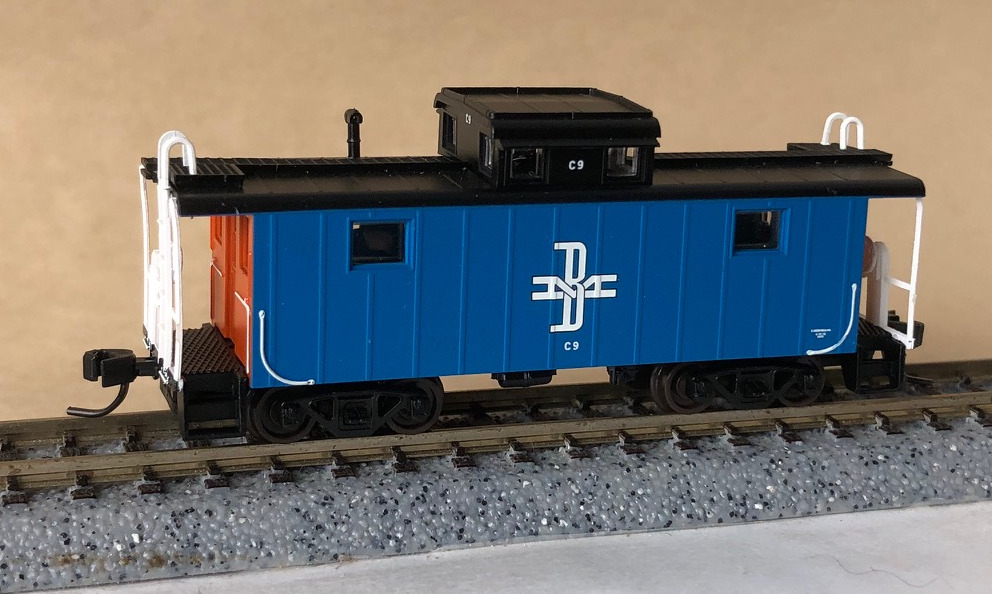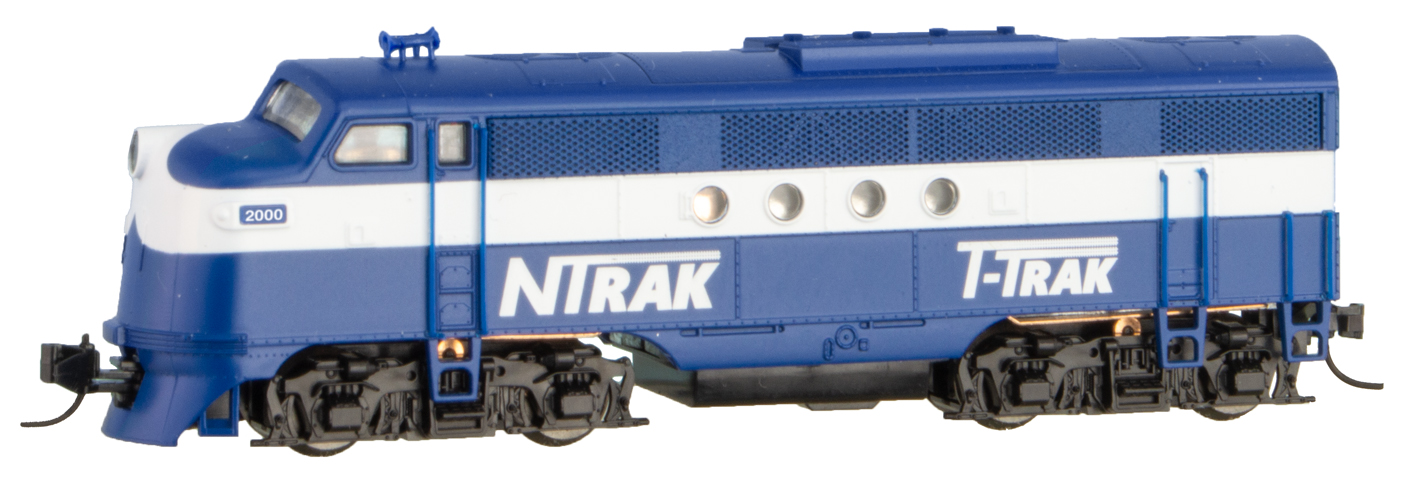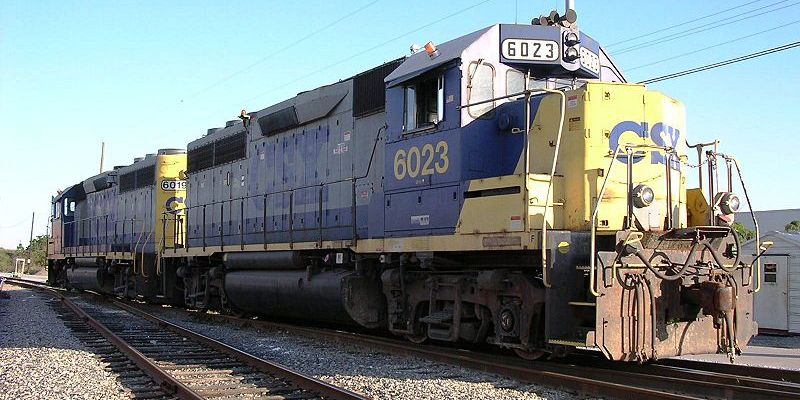Specific Item Information: with Dynamic brakes
Model Information: This model was introduced in 1997 with a DCC-ready chassis, and was also offered with a pre-installed Lenz decoder.
The same mechanism is used for the GP38, GP38-2, GP40 and GP40-2 since 1997. The earlier version of 1996 of the GP-40 was not yet DCC-Ready.
All versions use a dual-flywheel, split frame chassis with a 5-Pole skew-wound motor.
The current model features:
The same mechanism is used for the GP38, GP38-2, GP40 and GP40-2 since 1997. The earlier version of 1996 of the GP-40 was not yet DCC-Ready.
All versions use a dual-flywheel, split frame chassis with a 5-Pole skew-wound motor.
The current model features:
- Golden-white LEDs;
- Separately-applied roof detail;
- Painted safety rails;
- Directional lighting;
- Blackened metal wheels;
- Scale Speed motor;
- Separately-applied coupler cut levers;
- Non-Dynamic, Dynamic, and Extended Range Dynamic Brakes used where appropriate;
- Pilot: Standard or with Snow Plow;
- Low short hood and High short hood versions available.
DCC Information: DCC-Ready model, accepting a 1 Amp N Scale Mobile Decoder for Atlas N-Scale GP40-2, U25B, SD35, Trainmaster, B23-7 and others (DN163A0) from digitrax.com.
Prototype History: The EMD GP40-2 is a 4-axle diesel road switcher locomotive built by General Motors Electro-Motive Division as part of its Dash 2 line between April 1972 and December 1986. The locomotive's power is provided by an EMD 645E3 16-cylinder engine which generates 3,000 horsepower (2.24 MW).
Standard GP40-2 production totalled 861 units, with 817 built for U.S. railroads, and 44 for Mexican railroads. In addition, three GP40P-2s, passenger versions of the GP40-2, were built for Southern Pacific in 1974, and 279 GP40-2L(W) and GP40-2(W) units, equipped with wide-nosed cabs, were built by General Motors Diesel (GMD), for Canadian National and GO Transit between 1974 and 1976. Of the CN units, 233 were built with a taller and lighter frame to allow for a larger fuel tank. These units were officially classified GP40-2L but are commonly referred to as GP40-2L(W). The balance of CN's fleet, 35 units, and the 11 unit GO Transit fleet, used standard frames and smaller fuel tanks; they are often referred to as GP40-2(W) but are classified as GP40-2. Total production of the GP40-2 and its variations totalled 1,143 units.
The external spotting differences between the GP40 and the GP40-2 are very minor, as the main improvements reside on the engine and electronic control. A noticeable one is the water-level sight gauge on the right (engineer) side below the first radiator fan.
Although the GP40-2 was a sales success, it sold fewer units than the earlier GP40 and the contemporary GP38-2 and SD40-2 models. The popularity of high-horsepower 4-axle diesels began to decline with the GP40-2, with 6-axle models gaining in popularity for their superior low-speed lugging performance
From Wikipedia
Standard GP40-2 production totalled 861 units, with 817 built for U.S. railroads, and 44 for Mexican railroads. In addition, three GP40P-2s, passenger versions of the GP40-2, were built for Southern Pacific in 1974, and 279 GP40-2L(W) and GP40-2(W) units, equipped with wide-nosed cabs, were built by General Motors Diesel (GMD), for Canadian National and GO Transit between 1974 and 1976. Of the CN units, 233 were built with a taller and lighter frame to allow for a larger fuel tank. These units were officially classified GP40-2L but are commonly referred to as GP40-2L(W). The balance of CN's fleet, 35 units, and the 11 unit GO Transit fleet, used standard frames and smaller fuel tanks; they are often referred to as GP40-2(W) but are classified as GP40-2. Total production of the GP40-2 and its variations totalled 1,143 units.
The external spotting differences between the GP40 and the GP40-2 are very minor, as the main improvements reside on the engine and electronic control. A noticeable one is the water-level sight gauge on the right (engineer) side below the first radiator fan.
Although the GP40-2 was a sales success, it sold fewer units than the earlier GP40 and the contemporary GP38-2 and SD40-2 models. The popularity of high-horsepower 4-axle diesels began to decline with the GP40-2, with 6-axle models gaining in popularity for their superior low-speed lugging performance
From Wikipedia
Road Name History:  Although they may be molded in color, unpainted and unlettered, undecorated products are marketed to modelers who seek to custom decorate their models for private roads and/or road and/or company names that were not commercially produced by any of the major manufacturers.
Although they may be molded in color, unpainted and unlettered, undecorated products are marketed to modelers who seek to custom decorate their models for private roads and/or road and/or company names that were not commercially produced by any of the major manufacturers.
Undecorated models are frequently also unassembled or only partially assembled and required modelers to be comfortable with glue, paint and sometimes solder in order to prepare their models for display. Materials for these models can vary but often include plastic, pewter and resin. Models may or may not come with decals or other decorations such as plastic signage, railings and ladders to enhance the appearance of the final product.

Undecorated models are frequently also unassembled or only partially assembled and required modelers to be comfortable with glue, paint and sometimes solder in order to prepare their models for display. Materials for these models can vary but often include plastic, pewter and resin. Models may or may not come with decals or other decorations such as plastic signage, railings and ladders to enhance the appearance of the final product.
Brand/Importer Information: In 1924 Stephan Schaffan, Sr. founded the Atlas Tool Company in Newark, New Jersey. In 1933 his son, Stephan Schaffan, Jr., came to work for his father at the age of sixteen. Steve Jr. built model airplanes as a hobby and frequented a local hobby shop. Being an enterprising young man, he would often ask the owner if there was anything he could do to earn some extra spending money. Tired of listening to his requests, the hobby-store owner threw some model railroad track parts his way and said, "Here, see if you can improve on this".
In those days, railroad modelers had to assemble and build everything from scratch. Steve Jr. created a "switch kit" which sold so well, that the entire family worked on them in the basement at night, while doing business as usual in the machine shop during the day.
Subsequently, Steve Jr. engineered the stapling of rail to fiber track, along with inventing the first practical rail joiner and pre-assembled turnouts and flexible track. All of these products, and more, helped to popularize model railroading and assisted in the creation of a mass-market hobby. The budding entrepreneur quickly outgrew the limitations of a basement and small garage operation. Realizing they could actually make a living selling track and related products, Steve and his father had the first factory built in Hillside, New Jersey at 413 Florence Avenue in 1947. On September 30, 1949, the Atlas Tool Company was officially incorporated as a New Jersey company.
In 1985, Steve was honored posthumously for his inventions by the Model Railroad Industry Association and was inducted into the Model Railroad Industry Hall of Fame in Baltimore, Maryland. In addition, Steve was nominated and entered into the National Model Railroad Association Pioneers of Model Railroading in 1995.
In the early 1990s, the Atlas Tool Company changed its name to Atlas Model Railroad Company, Inc.
In those days, railroad modelers had to assemble and build everything from scratch. Steve Jr. created a "switch kit" which sold so well, that the entire family worked on them in the basement at night, while doing business as usual in the machine shop during the day.
Subsequently, Steve Jr. engineered the stapling of rail to fiber track, along with inventing the first practical rail joiner and pre-assembled turnouts and flexible track. All of these products, and more, helped to popularize model railroading and assisted in the creation of a mass-market hobby. The budding entrepreneur quickly outgrew the limitations of a basement and small garage operation. Realizing they could actually make a living selling track and related products, Steve and his father had the first factory built in Hillside, New Jersey at 413 Florence Avenue in 1947. On September 30, 1949, the Atlas Tool Company was officially incorporated as a New Jersey company.
In 1985, Steve was honored posthumously for his inventions by the Model Railroad Industry Association and was inducted into the Model Railroad Industry Hall of Fame in Baltimore, Maryland. In addition, Steve was nominated and entered into the National Model Railroad Association Pioneers of Model Railroading in 1995.
In the early 1990s, the Atlas Tool Company changed its name to Atlas Model Railroad Company, Inc.
Item created by: Steve German on 2016-04-11 18:21:21. Last edited by gdm on 2020-06-27 08:53:44
If you see errors or missing data in this entry, please feel free to log in and edit it. Anyone with a Gmail account can log in instantly.
If you see errors or missing data in this entry, please feel free to log in and edit it. Anyone with a Gmail account can log in instantly.


